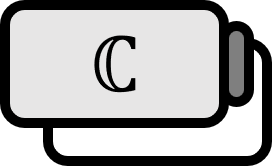Conjugate Complex Number
Definition
Let’s define a complex number as $z$ with $z=a+ib(a,b\in \mathbb{R})$.
$\overline{z}$ is defined as follows and is called the Complex Conjugate of $z$. $$ \overline{z}:=\overline{a+ib}=a-ib $$
Explanation
It can be explained as substituting $-i$ for $i$ in the original complex number, and as a reflection across the real axis on the complex plane. The term conjugate seems to be named because it forms a pair that produces a real number when added together. Conjugate complex numbers are one of the first concepts encountered when studying complex analysis, but they often neglect to study it as there seems to be no immediate use for it. However, it is important to master these properties through repetition rather than just learning them. Usually, since these are not mentioned in books after [5], it’s a good idea to learn them at the shrimp sushi place and take advantage of them.
Properties
Let’s define as $z_{1}$, $z_{2}$, $z \in \mathbb{C}$. Then, the following equations hold.
- [1]: $(z+\overline{z}) = 2 \re(z) \in \mathbb{R}$
- [2]: $\overline{z_{1} + z_{2}} = \overline{z_{1}} + \overline{z_{2}}$
- [3]: $\overline{z_{1} z_{2}} = \overline{z_{1}} \cdot \overline{z_{2}}$
- [4]: $\overline{ \overline{z} } = z$
- [5]: $z \overline{z} = |z|^2$
- [6]: $\overline{ \left( { \dfrac{1}{z} } \right) } = \dfrac{1}{\overline{z}}$
- [7]: $\overline{ \left( \dfrac{z_{1}}{z_{2}} \right) } = \dfrac{\overline{z_{1}}}{\overline{z_{2}}}$
- [8]: $\overline{ \sin{ z } } = \sin{\overline{z}}$
- [9]: $\overline{ \cos{ z } } = \cos{\overline{z}}$
- [10]: $\overline{ e^{ z } } = e^{\overline{z}}$
- [11]: $\overline{ \cosh{z} } = \cosh{\overline{z}}$
- [12]: $\overline{ \tan{ z } } = \tan{\overline{z}}$
Proof
Before proving, let’s define variables as $z_{1} = x_{1} + i y_{1}$, $z_{2} = x_{2} + i y_{2}$, $z = x + i y$.
[1]
Because of $$ z +\overline{z} = (x+iy)+(x-iy) = 2x $$,
$(z+\overline{z})=2x\in \mathbb{R}$ is true.
■
[2]
Because of $$ \begin{align*} \overline{z_{1} + z_{2}} =& \overline{ ( x_{1} + i y_{2} ) + ( x_{2} + i y_{2} ) } \\ =& \overline{ ( x_{1} + x_{2} ) + i ( y_{1} + y_{2} ) } \\ =& ( x_{1} + x_{2} ) - i ( y_{1} + y_{2} ) \\ &=(x_{1} - i y_{1}) + (x_{2} - i y_{2}) \\ =& \overline{z_{1}} + \overline{z_{2}} \end{align*} $$,
■
[3]
Because of $$ \begin{align*} \overline{z_{1} z_{2}} =& \overline{ ( x_{1} + i y_{1} ) ( x_{2} + i y_{2} ) } \\ =& \overline{( x_{1} x_{2} - y_{1} y_{2} ) + i ( x_{1} y_{2} + y_{1} x_{2} )} \\ =& ( x_{1} x_{2} - y_{1} y_{2} ) - i ( x_{1} y_{2} + y_{1} x_{2} ) \\ =& ( x_{1} - i y_{1} ) ( x_{2} - i y_{2} ) \\ =& \overline{( x_{1} + i y_{1} )} \ \overline{( x_{2} + i y_{2} )} \\ =& \overline{z_{1}} \cdot \overline{z_{2}} \end{align*} $$,
■
[4]
Because of $$ \overline{ \overline{ z } } = \overline{ x - i y } = x + i y =z $$,
■
[5]
Because of $$ z \overline{z} = (x + iy ) ( x - i y )= x^2 + y^2 =|z|^2 $$,
■
[6]
Because of $$ \overline{ \left( { {1} \over {z} } \right) } = \overline{ \left( {1} \over { x + iy } \right) } = \overline{{x - i y} \over {x ^ 2 + y^2 }} = {{x + i y} \over {x ^ 2 + y^2 }} = {{1} \over {x - i y }} = {{1} \over { \overline{z} }} $$,
■
[7]
- Because of [3], [6], $$ \overline{ \left( { {z_{1}} \over { z_{2} } } \right) } = \overline{ z_{1} { {1} \over { z_{2} } }}=\overline{z_{1}}\cdot \overline{ \left( {1} \over { z_{2} } \right) } = \overline{z_{1}}\cdot { 1 \over \overline{z_{2}} } = {{\overline{z_{1}}} \over { \overline{z_{2}} }} $$
■
[8] [9]
The proofs for [8] and [9] are essentially the same, so the proof for [9] is omitted.
$$ \begin{align*} \overline{ \sin{ z } } =& \overline{\sin{(x+ i y)}} \\ =& \overline{ \sin{x} \cosh{y} - i \cos{x} \sinh{y} } \\ =& { \sin{x} \cosh{y} + i \cos{x} \sinh{y} } \\ =& \sin{(x-iy)} \\ =& \sin{ \overline{z} } \end{align*} $$
■
[10]
By the Euler’s formula, the following holds.
$$ \overline{e^z} = \overline{\cos{x} + i \sin{y}} = \cos{x} - i \sin{y} =e^{\overline{z}} $$
■
[11]
Because of [7], [10],
$$ \overline{\cosh{z}} = \overline{\left( \dfrac{e^{z} + e^{-z}}{2} \right)} = \dfrac{ e^{\overline{z}} + e^{-\overline{z}} } {2} = \cosh\overline{z} $$
■
[12]
Because of [7], [8], [9],
$$ \overline{ \tan{z} } = \overline{ \left( { \sin{z} } \over { \cos{z} }\right) } = {{ \overline{\sin{z}} } \over { \overline{\cos{z}} }} = {{ \sin{ \overline{z} } } \over { \cos { \overline{z} } }} = \tan{ \overline{z} } $$
■
Supplementary
As you can see from the proof process, [11] can also be applied to other hyperbolic functions. It’s not that only those functions are important enough to warrant their proof separately, but to just show that such good properties can easily be derived. The same goes for trigonometric functions, so try it out for yourself.
- [13]: $\dfrac{1 + i}{1 - i } = i$
- [14]: $\dfrac{1 - i}{1 + i } = -i$
- [15]: $\dfrac{1}{i } = -i$
- [16]: $i \cdot (- i ) = 1$
Though not exactly a formula, these calculations with imaginary numbers are used very frequently and mastering them can drastically reduce the amount of calculation required. Especially, [15] is very useful in situations where reducing or multiplying both sides by an imaginary number is involved.
